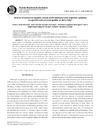Please use this identifier to cite or link to this item:
https://accedacris.ulpgc.es/jspui/handle/10553/45424
| DC Field | Value | Language |
|---|---|---|
| dc.contributor.author | Zurita Herrera, Pedro | en_US |
| dc.contributor.author | Delgado Bermejo, Juan Vicente | en_US |
| dc.contributor.author | Argüello Henríquez, Anastasio | en_US |
| dc.contributor.author | Camacho Vallejo, María Esperanza | en_US |
| dc.contributor.author | Germano Costa, Roberto | en_US |
| dc.date.accessioned | 2018-11-22T09:44:14Z | - |
| dc.date.available | 2018-11-22T09:44:14Z | - |
| dc.date.issued | 2011 | en_US |
| dc.identifier.issn | 1516-3598 | en_US |
| dc.identifier.other | WoS | - |
| dc.identifier.uri | https://accedacris.ulpgc.es/handle/10553/45424 | - |
| dc.description.abstract | The aim of this research was to study the effects of three different management systems on growth and carcass quality of 61 Murciano-Granadina breed kids and their interaction with sex. In the extensive system, 21 kids were allocated to suckle from their dams on free-range pasture with no additional feedstuff. In the semi-intensive system, 20 kids were suckled from their dams and had access to alfalfa hay and cereal straw (no free-range pasture). In the intensive system, 20 kids were separated from the dams at birth and then fed with milk replacer and alfalfa hay. Animals were slaughtered at 7.00 ± 1.00 kg of average BW. The semi-intensive system and extensive system kids grew faster than intensive system animals (127, 113 and 96 g/d, respectively). Differences in energy intake may explain these differences. Intensive system kids displayed the lowest real dressing percentages, calculated as 100 × (hot carcass weight/empty body weight), due to high development of empty gastrointestinal tract. The long leg and carcass were larger in extensive system kids than in kids from other management systems, presumably due to high physical activity on the free-range pastures. The carcasses and cuts from semi-intensive system and extensive system kids displayed more fat than those of intensive system kids. Males grew faster than females (122 and 103 g/d, respectively). Carcasses in male kids showed a higher content of bones but a lower content of fat than carcasses in female kids. The extensive system is feasible for producing kid meat from a dairy breed. | en_US |
| dc.language | eng | en_US |
| dc.publisher | 1516-3598 | - |
| dc.relation.ispartof | Revista Brasileira de Zootecnia | en_US |
| dc.source | Revista Brasileira de Zootecnia [ISSN 1516-3598], v. 40, p. 2613-2620 | en_US |
| dc.subject | 3104 Producción Animal | en_US |
| dc.subject.other | Meat Quality | en_US |
| dc.subject.other | Live Weight | en_US |
| dc.subject.other | Goat | en_US |
| dc.subject.other | Slaughter | en_US |
| dc.subject.other | Attributes | en_US |
| dc.subject.other | Traits | en_US |
| dc.subject.other | Level | en_US |
| dc.subject.other | Average Daily Gain | en_US |
| dc.subject.other | Meat | en_US |
| dc.subject.other | Murciano-Granadina Breed | en_US |
| dc.title | Effects of extensive system versus semi-intensive and intensive systems on growth and carcass quality of dairy kids | en_US |
| dc.type | info:eu-repo/semantics/Article | en_US |
| dc.type | Article | en_US |
| dc.identifier.doi | 10.1590/S1516-35982011001100045 | en_US |
| dc.identifier.scopus | 84856291072 | - |
| dc.identifier.isi | 000297796400045 | - |
| dc.contributor.authorscopusid | 54923503300 | - |
| dc.contributor.authorscopusid | 15051707200 | - |
| dc.contributor.authorscopusid | 36521034900 | - |
| dc.contributor.authorscopusid | 36522051300 | - |
| dc.contributor.authorscopusid | 7203063287 | - |
| dc.description.lastpage | 2620 | en_US |
| dc.identifier.issue | 11 | - |
| dc.description.firstpage | 2613 | en_US |
| dc.relation.volume | 40 | en_US |
| dc.investigacion | Ciencias de la Salud | en_US |
| dc.type2 | Artículo | en_US |
| dc.contributor.daisngid | 30469759 | - |
| dc.contributor.daisngid | 426162 | - |
| dc.contributor.daisngid | 6448494 | - |
| dc.contributor.daisngid | 6697810 | - |
| dc.contributor.daisngid | 27997583 | - |
| dc.description.numberofpages | 8 | en_US |
| dc.utils.revision | Sí | en_US |
| dc.contributor.wosstandard | WOS:Herrera, PZ | - |
| dc.contributor.wosstandard | WOS:Bermejo, JVD | - |
| dc.contributor.wosstandard | WOS:Henriquez, AA | - |
| dc.contributor.wosstandard | WOS:Vallejo, MEC | - |
| dc.contributor.wosstandard | WOS:Costa, RG | - |
| dc.date.coverdate | Enero 2011 | en_US |
| dc.identifier.ulpgc | Sí | en_US |
| dc.contributor.buulpgc | BU-VET | en_US |
| dc.description.sjr | 0,458 | |
| dc.description.sjrq | Q2 | |
| item.fulltext | Con texto completo | - |
| item.grantfulltext | open | - |
| crisitem.author.dept | GIR IUSA-ONEHEALTH 4. Producción y Biotecnología Animal | - |
| crisitem.author.dept | IU de Sanidad Animal y Seguridad Alimentaria | - |
| crisitem.author.dept | Departamento de Patología Animal, Producción Animal, Bromatología y Tecnología de Los Alimentos | - |
| crisitem.author.orcid | 0000-0002-4426-0678 | - |
| crisitem.author.parentorg | IU de Sanidad Animal y Seguridad Alimentaria | - |
| crisitem.author.fullName | Argüello Henríquez, Anastasio | - |
| Appears in Collections: | Artículos | |
SCOPUSTM
Citations
15
checked on Jun 8, 2025
WEB OF SCIENCETM
Citations
12
checked on Jan 18, 2026
Page view(s)
246
checked on Jan 15, 2026
Download(s)
101
checked on Jan 15, 2026
Google ScholarTM
Check
Altmetric
Share
Export metadata
Items in accedaCRIS are protected by copyright, with all rights reserved, unless otherwise indicated.
